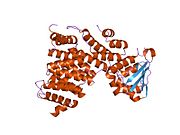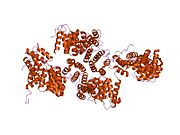Biology:PEX5
From HandWiki
Short description: Protein-coding gene in the species Homo sapiens
 Generic protein structure example |
Peroxisomal targeting signal 1 receptor (PTS1R) is a protein that in humans is encoded by the PEX5 gene.[1]
PTS1R is a peroxisomal targeting sequence involved in the specific transport of molecules for oxidation inside the peroxisome. SKL binds to PTS1R in the cytosol followed by binding to the Pex14p receptor allowing importation of the peroxisomal protein through the pexsubunit transporter.
Diseases associated with dysfunctional PTS1R receptors include X-linked adrenoleukodystrophy and Zellweger syndrome.
Interactions
PEX5 has been shown to interact with PEX12,[2][3] PEX13[4][5] and PEX14.[3][5][6]
References
- ↑ "Entrez Gene: PEX5 Peroxisomal biogenesis factor 5". https://www.ncbi.nlm.nih.gov/sites/entrez?Db=gene&Cmd=ShowDetailView&TermToSearch=5830.
- ↑ "PEX12 interacts with PEX5 and PEX10 and acts downstream of receptor docking in peroxisomal matrix protein import". The Journal of Cell Biology 147 (4): 761–74. Nov 1999. doi:10.1083/jcb.147.4.761. PMID 10562279.
- ↑ 3.0 3.1 "Molecular anatomy of the peroxin Pex12p: ring finger domain is essential for Pex12p function and interacts with the peroxisome-targeting signal type 1-receptor Pex5p and a ring peroxin, Pex10p". The Journal of Biological Chemistry 275 (33): 25700–10. Aug 2000. doi:10.1074/jbc.M003303200. PMID 10837480.
- ↑ "Pex13p is an SH3 protein of the peroxisome membrane and a docking factor for the predominantly cytoplasmic PTs1 receptor". The Journal of Cell Biology 135 (1): 85–95. Oct 1996. doi:10.1083/jcb.135.1.85. PMID 8858165.
- ↑ 5.0 5.1 "Peroxisomal targeting signal receptor Pex5p interacts with cargoes and import machinery components in a spatiotemporally differentiated manner: conserved Pex5p WXXXF/Y motifs are critical for matrix protein import". Molecular and Cellular Biology 22 (6): 1639–55. Mar 2002. doi:10.1128/MCB.22.6.1639-1655.2002. PMID 11865044.
- ↑ "The peroxin Pex14p. cDNA cloning by functional complementation on a Chinese hamster ovary cell mutant, characterization, and functional analysis". The Journal of Biological Chemistry 274 (18): 12593–604. Apr 1999. doi:10.1074/jbc.274.18.12593. PMID 10212238.
Further reading
- "Identification and characterization of the putative human peroxisomal C-terminal targeting signal import receptor". The Journal of Biological Chemistry 270 (13): 7731–6. Mar 1995. doi:10.1074/jbc.270.13.7731. PMID 7706321.
- "Mutations in the PTS1 receptor gene, PXR1, define complementation group 2 of the peroxisome biogenesis disorders". Nature Genetics 9 (2): 115–25. Feb 1995. doi:10.1038/ng0295-115. PMID 7719337.
- "Human peroxisomal targeting signal-1 receptor restores peroxisomal protein import in cells from patients with fatal peroxisomal disorders". The Journal of Cell Biology 130 (1): 51–65. Jul 1995. doi:10.1083/jcb.130.1.51. PMID 7790377.
- "Oligo-capping: a simple method to replace the cap structure of eukaryotic mRNAs with oligoribonucleotides". Gene 138 (1–2): 171–4. Jan 1994. doi:10.1016/0378-1119(94)90802-8. PMID 8125298.
- "The gene for the peroxisomal targeting signal import receptor (PXR1) is located on human chromosome 12p13, flanked by TPI1 and D12S1089". Genomics 30 (2): 366–8. Nov 1995. doi:10.1006/geno.1995.0032. PMID 8586442.
- "Pex13p is an SH3 protein of the peroxisome membrane and a docking factor for the predominantly cytoplasmic PTs1 receptor". The Journal of Cell Biology 135 (1): 85–95. Oct 1996. doi:10.1083/jcb.135.1.85. PMID 8858165.
- "Multiple PEX genes are required for proper subcellular distribution and stability of Pex5p, the PTS1 receptor: evidence that PTS1 protein import is mediated by a cycling receptor". The Journal of Cell Biology 135 (6 Pt 2): 1763–74. Dec 1996. doi:10.1083/jcb.135.6.1763. PMID 8991089.
- "Construction and characterization of a full length-enriched and a 5'-end-enriched cDNA library". Gene 200 (1–2): 149–56. Oct 1997. doi:10.1016/S0378-1119(97)00411-3. PMID 9373149.
- "Mutations in PEX1 are the most common cause of peroxisome biogenesis disorders". Nature Genetics 17 (4): 445–8. Dec 1997. doi:10.1038/ng1297-445. PMID 9398847.
- "Peroxisome targeting signal type 1 (PTS1) receptor is involved in import of both PTS1 and PTS2: studies with PEX5-defective CHO cell mutants". Molecular and Cellular Biology 18 (1): 388–99. Jan 1998. doi:10.1128/mcb.18.1.388. PMID 9418886.
- "Identification of a human PTS1 receptor docking protein directly required for peroxisomal protein import". Proceedings of the National Academy of Sciences of the United States of America 95 (14): 8087–92. Jul 1998. doi:10.1073/pnas.95.14.8087. PMID 9653144. Bibcode: 1998PNAS...95.8087F.
- "C-terminal tripeptide Ser-Asn-Leu (SNL) of human D-aspartate oxidase is a functional peroxisome-targeting signal". The Biochemical Journal 336 (Pt 2): 367–71. Dec 1998. doi:10.1042/bj3360367. PMID 9820813.
- "The peroxin Pex14p. cDNA cloning by functional complementation on a Chinese hamster ovary cell mutant, characterization, and functional analysis". The Journal of Biological Chemistry 274 (18): 12593–604. Apr 1999. doi:10.1074/jbc.274.18.12593. PMID 10212238.
- "Functional heterogeneity of C-terminal peroxisome targeting signal 1 in PEX5-defective patients". Biochemical and Biophysical Research Communications 262 (2): 504–8. Aug 1999. doi:10.1006/bbrc.1999.1232. PMID 10462504.
- "PEX12 interacts with PEX5 and PEX10 and acts downstream of receptor docking in peroxisomal matrix protein import". The Journal of Cell Biology 147 (4): 761–74. Nov 1999. doi:10.1083/jcb.147.4.761. PMID 10562279.
- "Localization of a portion of extranuclear ATM to peroxisomes". The Journal of Biological Chemistry 274 (48): 34277–82. Nov 1999. doi:10.1074/jbc.274.48.34277. PMID 10567403. http://espace.library.uq.edu.au/view/UQ:143352/UQ143352_OA.pdf.
- "Molecular anatomy of the peroxin Pex12p: ring finger domain is essential for Pex12p function and interacts with the peroxisome-targeting signal type 1-receptor Pex5p and a ring peroxin, Pex10p". The Journal of Biological Chemistry 275 (33): 25700–10. Aug 2000. doi:10.1074/jbc.M003303200. PMID 10837480.
- "Peroxisomal targeting signal-1 recognition by the TPR domains of human PEX5". Nature Structural Biology 7 (12): 1091–5. Dec 2000. doi:10.1038/81930. PMID 11101887.
- "Hsp70 regulates the interaction between the peroxisome targeting signal type 1 (PTS1)-receptor Pex5p and PTS1". The Biochemical Journal 357 (Pt 1): 157–65. Jul 2001. doi:10.1042/0264-6021:3570157. PMID 11415446.
- "The di-aromatic pentapeptide repeats of the human peroxisome import receptor PEX5 are separate high affinity binding sites for the peroxisomal membrane protein PEX14". The Journal of Biological Chemistry 276 (37): 34524–9. Sep 2001. doi:10.1074/jbc.M104647200. PMID 11438541.
- "Recognition of a functional peroxisome type 1 target by the dynamic import receptor pex5p". Molecular Cell 24 (5): 653–63. Dec 2006. doi:10.1016/j.molcel.2006.10.024. PMID 17157249.
External links
- GeneReviews/NCBI/NIH/UW entry on Peroxisome Biogenesis Disorders, Zellweger Syndrome Spectrum
- OMIM entries on Peroxisome Biogenesis Disorders, Zellweger Syndrome Spectrum





